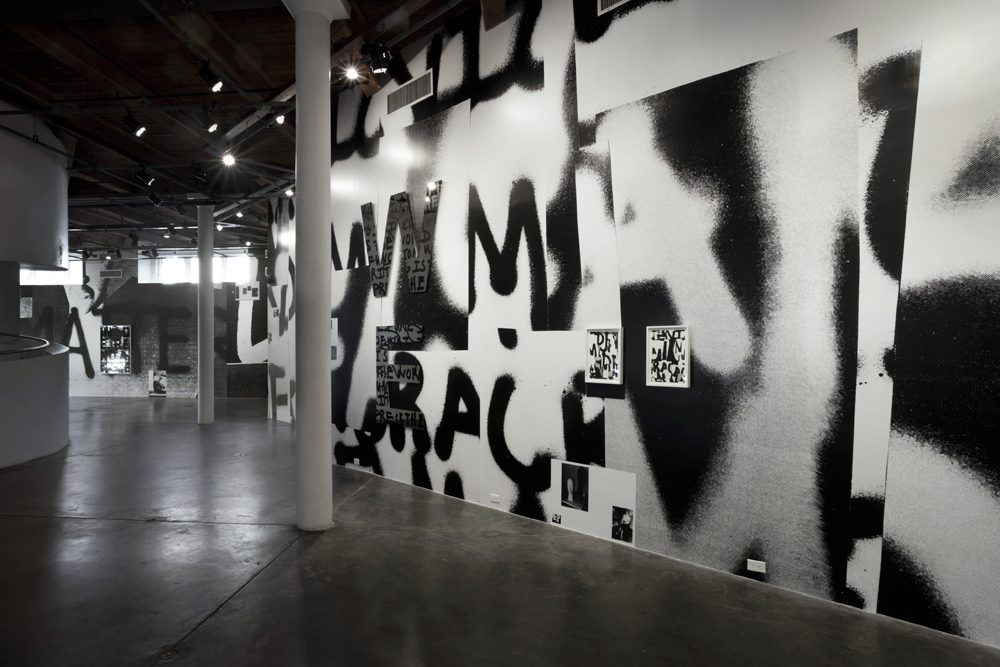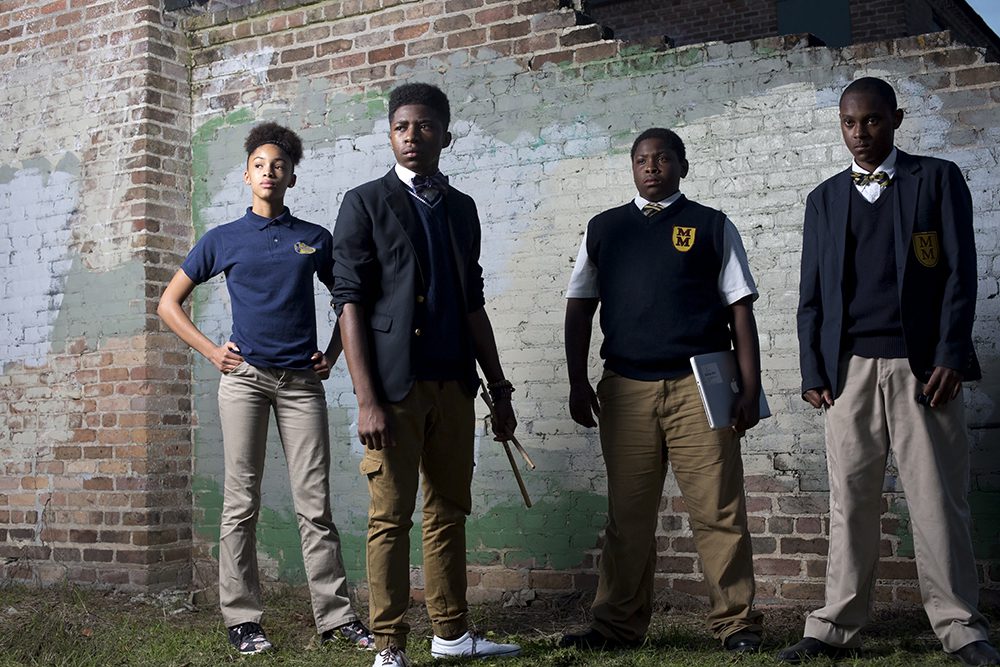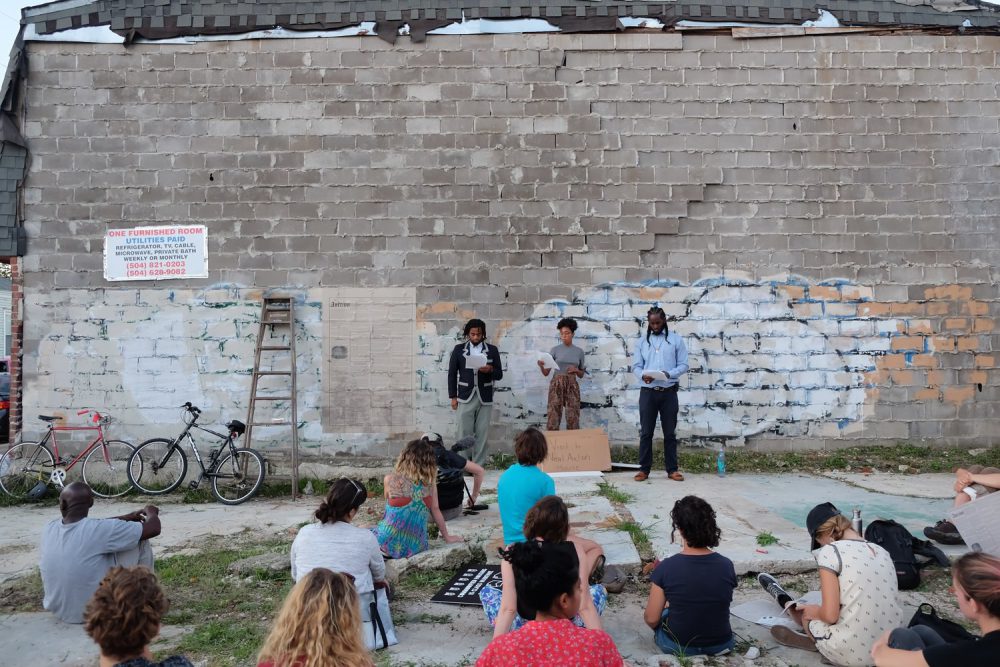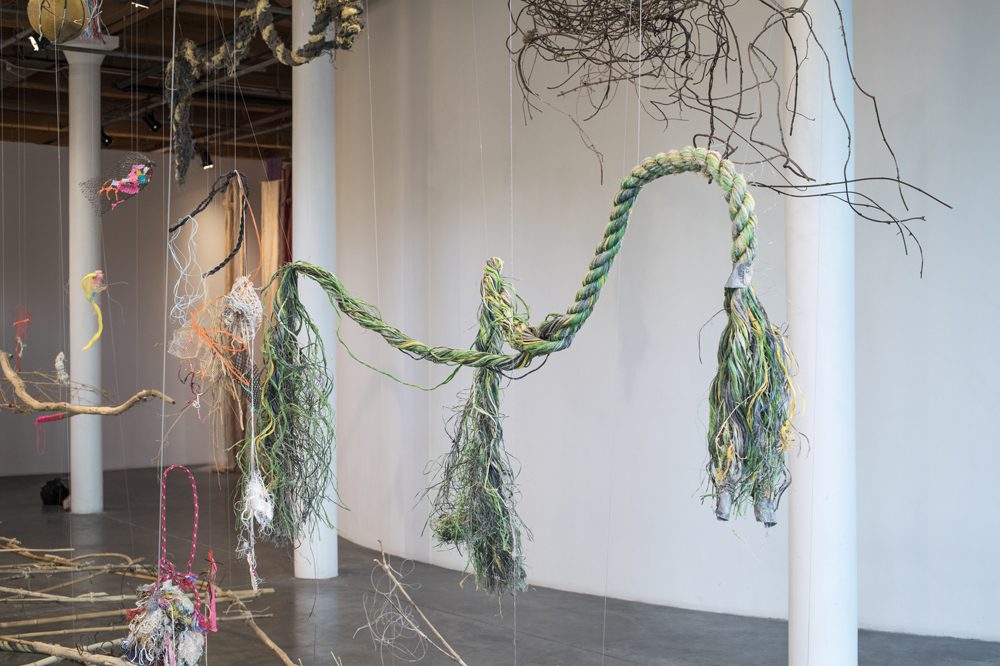The Power of Place: A Conversation on Living and Working in New Orleans
In a conversation commissioned for Field Perspectives 2017, Charlie Tatum talks with Andrea Andersson, Imani Jacqueline Brown, and L. Kasimu Harris about the difficulties, joys, and particularities of working in New Orleans.

A billboard on Galvez Street and Orleans Avenue as part of Blights Out’s Blights Out for Mayor campaign. Courtesy Blights Out, New Orleans.
Editor's Note
This conversation was commissioned by Pelican Bomb as part of Field Perspectives 2017, a co-publishing initiative organized and supported by Common Field as a part of their Los Angeles 2017 Convening. Field Perspectives 2017 is a collaboration between Common Field and nine arts publications across the country. Partners each commissioned a piece of writing that aims to catalyze discussion, dialogue, and debate before, during, and after the Convening.
When asked to contribute to this network of essays, interviews, and projects, Pelican Bomb organized a conversation, one of our favorite forms because of its ability to hold multiple voices. As the only New Orleans-based contributor, we counter the desire for a single cohesive narrative of our city by embracing a diversity of perspectives.
So, last month, I sat down with three colleagues—the four of us comprised of one artist, one curator, one administrator, and one critic—in an attempt to better articulate some of the issues we, as arts workers in New Orleans, collectively face. We focused on the relationship between practice and place, examining how the very fact of geography affects our daily lives—from disparities between wages and the cost of living to the seeming necessity to travel and remain in contact with arts communities in larger urban centers. We also thought about our roles here and within the international cultural landscape.
Andrea Andersson, Imani Jacqueline Brown, and L. Kasimu Harris, all native New Orleanians, shared with me their experiences leaving, loving, and relearning the city. Andersson is the Chief Curator of Visual Arts at the Contemporary Arts Center; Brown is a founding organizer of Blights Out, a core member of Occupy Museums, and Director of Programs at Antenna; and Harris is an independent artist and journalist whose work has been published in Oxford American and The FADER, among other publications.
—Charlie Tatum
Charlie Tatum: I want to start this conversation with a question we all think about: How does New Orleans relate to the work that you do day-to-day? And, in thinking about that, how did you end up doing that work here specifically?
Imani Jacqueline Brown: I’m from New Orleans, so New Orleans is something that I carry with me all the time and will always carry with me, not just because my family is from here and I went to school here. I am who I am because of New Orleans in a lot of ways. I left New Orleans after Katrina and went to school in New York and was involved in Occupy Wall Street—and I heard these anarchists squatting in the streets talking about the need to have mutual aid-societies. I started thinking about it and realized that we in New Orleans have been doing that for generations through Social Aid and Pleasure Clubs. I realized then how much New Orleans had influenced me and still had to teach me. I came back to be part of the city after having been gone for so long, and I won’t necessarily be here forever, but New Orleans will always be with me.
Andrea Andersson: I’m also from New Orleans, but I don't know that New Orleans traveled with me in the same way when I was studying and living elsewhere. My areas of study and scholarship were driven by other concerns. I became a true-to-form formalist. But I now know that the most interesting way to think about form is to recognize that it is necessarily political and social—so it’s interesting to see my practice change since returning to New Orleans three years ago. There are projects and undertakings that I thought of realizing elsewhere that made no sense the moment I was back on New Orleans’ soil. The social and political imperative became so much greater. It made me look at form in a really rigorous way.
CT: Do you have a specific example of how your viewpoint on a specific project shifted?
AA: Well, the Adam Pendleton exhibition that I realized at the CAC is just one possible example. I had always been interested in appropriation, textual appropriation, and the politics of textual appropriation, but Adam’s work seemed really important here because it was tapping into a very specific history. The question of who speaks and whose language we’re borrowing always holds weight, but in the city of New Orleans there are very particular histories that need to be narrated. And in my opinion, those are both the stories of the diverse communities that make up New Orleans but also the histories of contemporary art that may be less rehearsed here. I think there is a constant demand to put the familiar in contact with the unfamiliar, social histories in contact with aesthetic histories. And we do that from a very particular location and perspective in the Global South. Every time I show work here there’s a double question: What is the work that New Orleans needs to see, and also what is the work that needs to be translated through the lens of New Orleans? There’s a way of engaging with and devouring art here that makes certain work come back alive.

Installation view of “Adam Pendleton: Becoming Imperceptible” at the Contemporary Arts Center, New Orleans. Courtesy the artist; the Contemporary Arts Center, New Orleans; Pace Gallery, New York; Galeria Pedro Cera, Lisbon; and Galerie Eva Presenhuber, Zurich. Photo by Traviesa Studio.
CT: How has the city influenced you, Kasimu?
L. Kasimu Harris: I left New Orleans a semester after high school—I'm from New Orleans as well—and art had always been a curiosity to me, but when I left, I was more into performing arts and music. I was really into jazz—I’m still into jazz. When I was in high school, I was an aspiring professional trumpet player, and, when I went to college at Middle Tennessee State University, I started to pursue journalism, casually, and a few years later, I went to graduate school at Ole Miss, to pursue an M.A. in journalism. That’s the same year Hurricane Katrina happened, 2005. When I came back to New Orleans, like 45 days after Katrina, I picked up a camera. It still wasn’t a pursuit of art per se, but it was storytelling. It was part of a frustration that the stories and the narratives being reported out of New Orleans didn’t necessarily match what I experienced. A lot of people were doing parachute journalism, but I’m always a firm believer in telling our own stories. Now I’m still uncovering and trying to tell stories—some of the themes relate to New Orleans and some of them not at all.
AA: I want to think more about that, Kasimu, that you’re a firm believer in telling our own stories. I think that’s a really interesting question in the work we do here, because there is a way that New Orleans is this remarkable, navel-gazing city that always wants to tell its own story, at the exclusion of all the other stories that might happen. I’m curious about that balance, and I’m always thinking about this in my particular role at the Contemporary Arts Center. What is this institution? On one hand, the CAC seeks to be a global institution; but it also seeks to be a local institution—so how do we tell stories of global relevance that are also necessarily a reflection of our own experience?
CT: That’s really central to what we think about at Pelican Bomb. In publishing about contemporary art in the city, we have two audiences. There is the audience of folks here in New Orleans who are either artists or who are interested in the arts or who might be interested if we can convince them. And then there’s a separate audience of people in the art world at large who are looking to New Orleans to see what else is happening—
AA: —what else there might be, right? That question of what else might there be is something that feels really important right now.
IJB: Else to what?
AA: Else to the traditional historical narrative of contemporary art as it is translated through the eyes of New York or other art capitals. There is a question in America, and much further: What are the other stories? What are the stories we’re not telling?
IJB: When we think about the “art world” of New York and London and these various places that are invariably financial centers of some sort, places with great concentrations of wealth, we’re really thinking about the art world as being shaped around and by the art market. So yes, people are definitely like, Well, what else is there? as we’re realizing how flawed, limited, and self-destructive that [market-centric] perspective is. Art has become increasingly focused on its function as an asset class, and we’ve watched it become more abstracted, not in the formal sense, but abstracted from its social context and more concentrated on its financial context—as our own economies have also become more and more frenzied and abstracted from any real social value. As we’re watching, we’re realizing what a dead end our economic system is, what a dead end capitalism and neoliberalism are—and also recognizing what a dead end art focused on capital is. I think what’s really interesting about New Orleans is that, at least prior to Katrina, we were far behind in the neoliberalist game. Neoliberalism hadn’t really settled in here, and Katrina was the opening of the floodgates to allow for the privatization of everything and for the influx of moneyed interests and for profit to be sucked from so many things.
There are many things good and bad that have come with the influx of people and ideas since Katrina, and I’m all about the free flow of ideas and information. Katrina also had an outward momentum, as people from New Orleans were propelled to other parts of the world and were able to share their stories. When I was in New York, learning about Occupy Wall Street and this massive social and economic movement around rejecting capitalism, the status quo, and profit-seeking, to me, it was in a lot of ways an art movement. It was channelling African call and response through the People’s Mic. It had performance intimately interwoven in it and was reminiscent of voodoo circles. The movement was drawing on these—I hate the word—traditional, or maybe inherent, aspects of culture that everyone in the world carries deep within them. We still had and have that in New Orleans and express it through many different creative outlets. I think that is what is so attractive to people when they look at New Orleans. They see something before and beyond capitalism, and they want to know what that is and be a part of it.

L. Kasimu Harris, War on the Benighted #1, 2015. Digital photograph. Courtesy the artist.
CT: Can we return to your comment about concentrations of wealth? As we know from the practical realities of living in New Orleans, the wealth is not concentrated here—evidenced by the small number of jobs, the low wages, etc. While we think that the cost of living somewhere like New York is much higher— the funding structures there do better support the arts—even if those structures are precarious themselves. It would be arguably easier to work in a larger city, where that infrastructure already exists.
AA: Yes, and the relative cost of living in New Orleans is high. With the question of ease, I don’t think there’s an argument. I think it is easier to do the work that we do, easier to do almost any work, outside of New Orleans, and the arts are no exception to that.
CT: Can you think about that through a personal lens? What are the benefits of working here? It would be easier elsewhere, whether because of funding or because it’s easier to catch the eye of curators and writers and because it’s easier to be automatically included in this idea of an international art world—which is really just New York talking about itself most of the time. What are the benefits of being here?
AA: One of the great benefits of being here, which is maybe also a burden, is that there is a mandate to think very seriously, particularly during the current presidential administration, about what populism is. What are populist practices and what are inclusive practices? What’s traditional and what’s innovation? New Orleans has long been associated with tradition and, in terms of contemporary art, we are pursuing a version of New Orleans that is interested in innovation. It’s much easier to drive a public into an arts institution through a populist address, right? But I think that we, as a country, have explored over the last two years, some very dangerous ramifications of populist address.
LKH: Sometimes I think about “making it,” or getting the widest recognition. Even when I was a teenager, I wondered if you could fully do that living in New Orleans, or if you had to go somewhere else to make it. I think Katrina obviously shifted that, when the number of people, the long-time native residents, shifted and shrank, and the number of people from outside expanded. I still struggle with that a little bit. I think now you can make it living in New Orleans. But anything I’ve done outside of New Orleans is in some way connected back here.
As far as recognition, I feel ignored by the media here in New Orleans. It’s easier to get in a publication far from here than it is to get written about in New Orleans.
All, together: Mmhmm.
LKH: I think I’ve been written about by local publications twice, maybe. It’s like, man, I’ve been written about three times this year alone by national publications outside of the city, which is an odd kind of thing.
AA: Can I ask you why you think you’ve been written about by more national publications than local publications?
LKH: I don’t know, I’m trying to figure it out. The arts have been gutted. We have two major newspapers here, and then you think about whatever alternative weeklies we have, but then it also comes down to a problem about inclusion. It’s just a fact that people who write about arts and culture in New Orleans largely look one way, and it ain’t like me. The mainstream publications—the Times-Picayune, the New Orleans Advocate, even Offbeat or Gambit—they don’t have many writers of color or photographers of color. Too often, I feel that their influences and what they write about are very narrow and exclude, intentionally or unintentionally, too many artists
But why do I make work here? A lot of my work is based in New Orleans, but, as I try to scale out and explore other issues, I think eventually I’ll be more apt to leave or to move, but when you have a family structure, you get a little comfortable.

Blights Out’s Theater of the Gentrified reading and rally, as part of their Living Glossary Project, featuring A Scribe Called Quess?, Mariama Eversley, and Daquiri Rene Jones. Courtesy Blights Out, New Orleans.
AA: There is a different sense of mission when I am making work here. I know I’m making something that, if I don’t do it, my daughter or my son will not encounter here. That’s not true when I’m working in New York. There, I can be a great cultural consumer. My children can see so much stuff, and I don’t have to do anything right? It’s already out there. I do think that there’s that kind of responsibility to this community. I feel that we have to build it or it won’t be there.
IJB: I returned to New Orleans with a mission, to participate in my city, to be a part of it. I had seen disaster capitalism come up after Hurricane Sandy in New York, and was like, Shit, I have to go see what’s happening in my hometown. I have some work to do. I have some giving back to do. I had some guilt for not having been here after Katrina, and I needed to work through that. Katrina was my senior year of high school, and I never got to say goodbye. Even though I had planned on leaving, I never got to formally say goodbye. I needed to find closure, but realized that you can’t have closure with your home; there is no wrapping up. This is not the only place where I do work though. I’m pretty lucky to still have a practice with a collective in New York—Occupy Museums—and we’re still able to do projects. I’m lucky and privileged to have this base and to be able to travel and do projects around the world. All that is incredibly important to me.
AA: We’ve all referenced working further afield, being rooted in the city of New Orleans, but also operating elsewhere. That’s one of the most interesting things about New Orleans, and I think it distinguishes New Orleans from many other places. There is no way to think about the history or the culture of the city without acknowledging global trade exchanges and patterns, and the historical relationship of this city to every other place on the globe.
CT: These ideas bring up a practical question: How often do you all travel specifically to engage with art? Whether for work or pleasure, because of course that line is so blurred now. I most often go to New York because of the concentration of galleries and museums and also many friends and loved ones. Where do you all go and why?
LKH: I’ve been to Georgia maybe three or four times this year to Atlanta and to the art museum at LaGrange College, which surprised me. I went to New York twice this year, and every time I go I’m intentionally trying to see art. I got a chance to see the show at the Brooklyn Museum, “We Wanted a Revolution: Black Radical Women, 1965–85,” and then I saw the Whitney Biennial. I went to L.A. this year.
CT: Do you have specific goals for those trips, or is it more open-ended, trying to absorb as much as possible?
LKH: I’m not saying this to try to be funny, but I remember when I was an undergrad, in any city, I wanted to find a Kappa Alpha Psi Fraternity brother, and I hopefully knew a girl who lived there. I have a woman now, but the mentality is the same when I travel. I want to connect with people—personal or professional; sometimes it’s to see art or share a meal. You never know where it’s going to go, and then maybe something happens two, three years down the road. That organic practice, to meet people, has benefitted me, when I travel, to reach out and just say, “Hi,” and maybe have a drink.

Installation view of Cecilia Vicuña’s Balsa Snake Raft to Escape the Flood, 2017, at the Contemporary Arts Center, New Orleans. Found materials sourced from New Orleans, Chile, and New York. Courtesy the artist. Photo by Alex Marks Photography.
IJB: It’s a privilege to be able to travel and see the world and to have that exchange with people around the world, and that’s probably the most important thing in my life. I’ve always traveled a lot. My mother is an international law professor in New Orleans at Loyola, and she has a research stipend. So as a child I was definitely very privileged to have been born of this woman who would only have to to pay for a plane ticket and then everything else was covered. It really gave me this unquenchable thirst to learn from other people and see how we’re all connected, how our struggles are connected. Today I travel to New York a lot. I am grateful to have been a part of the Whitney Biennial with Occupy Museums this March, so I had to travel there. When I left New York in 2013, I was worried that I was going to miss it, but I’ve been lucky to return frequently.
I’ve also had some really incredible opportunities to travel globally. I'm travelling to the U.K. and Poland this fall for a fellowship and a residency. I’ve done a lot of traveling, to the point where I start to feel uncomfortable about it. I start to calculate my carbon footprint. So I’ve come to realize that the way I live my life, as much as I love it, is really unsustainable.
AA: I travel more than I wish I did. I love to travel, but I also have two small children, so it’s harder and it’s different than it ever was before. There isn’t a month that I don’t travel to New York. I also go to many other cities for traveling shows and to see the work of colleagues—which is important and different than visiting New York where there is simply such a density of experience. But I am curious about what and how works gets shown and resonates in different places and regions across this country.
Still, more than anything, I tend to think of New Orleans in a transnational context. So it feels important to me to leave the country and to look back on what we’re doing from that perspective. I was fortunate this summer to be able to see the international art presentations going on in Europe, and this fall I will return again for work. It seems to be the condition of the work, partially because I think we are tasked with the job of holding a conversation in New Orleans and making sure that New Orleans is also in all the other conversations. I think we all serve as ambassadors of this city. I probably spend as much time narrating what happens here for others who don’t live here as I am doing work here on the ground.
LKH: Is there a particular point that you all started working outside of New Orleans? And is that opportunity granted to everyone or is it not? I don’t think so. What do you think made us different? I can’t necessarily answer that for myself, but it’s something that I grapple with.
AA: I think that a lot of it has to do with opportunity, and I think that opportunity affords imagination. Neither of my parents were from New Orleans. My father is German and my mother is Greek. And that meant that elsewhere was always part of my experience of the world. In your case, Imani, you were always traveling with your mom—
IJB: I was inspired by her, of course, but to get to the point where I now have my own kind of momentum and my own propeller giving me opportunities; I have to create those. I think, in large part, the privilege that allowed me to leave and develop more projects elsewhere was the privilege to evacuate during Katrina. I often think about the fact that there are so many people here who’ve never left New Orleans, and as a result their lives might be incredibly rich and fulfilling but they might also take it for granted because I took it for granted, until I went to New York, or until I went to D.C. and was like, Oh, that’s how y’all live? I always saw myself leaving New Orleans and hated so many things, and then I realized there’s so much to love about it.



